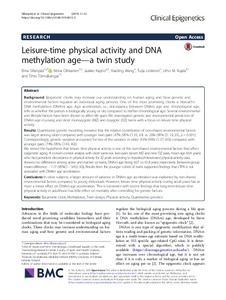Leisure-time physical activity and DNA methylation agea twin study
Elina Sillanpää; Miina Ollikainen; Jaakko Kaprio; Xiaoling Wang; Tuija Leskinen; Urho M. Kujala; Timo Törmäkangas
Leisure-time physical activity and DNA methylation agea twin study
Elina Sillanpää
Miina Ollikainen
Jaakko Kaprio
Xiaoling Wang
Tuija Leskinen
Urho M. Kujala
Timo Törmäkangas
BMC
Julkaisun pysyvä osoite on:
https://urn.fi/URN:NBN:fi-fe2021042825022
https://urn.fi/URN:NBN:fi-fe2021042825022
Tiivistelmä
BackgroundEpigenetic clocks may increase our understanding on human aging and how genetic and environmental factors regulate an individual aging process. One of the most promising clocks is Horvath's DNA methylation (DNAm) age. Age acceleration, i.e., discrepancy between DNAm age and chronological age, tells us whether the person is biologically young or old compared to his/her chronological age. Several environmental and lifestyle factors have been shown to affect life span. We investigated genetic and environmental predictors of DNAm age in young and older monozygotic (MZ) and dizygotic (DZ) twins with a focus on leisure time physical activity.ResultsQuantitative genetic modeling revealed that the relative contribution of non-shared environmental factors was larger among older compared with younger twin pairs [47% (95% CI 35, 63) vs. 26% (95% CI: 19, 35), p<0.001]. Correspondingly, genetic variation accounted for less of the variance in older [53% (95% CI 37, 65)] compared with younger pairs [74% (95% CI 65, 82)].We tested the hypothesis that leisure time physical activity is one of the non-shared environmental factors that affect epigenetic aging. A co-twin control analysis with older same-sex twin pairs (seven MZ and nine DZ pairs, mean age 60.4years) who had persistent discordance in physical activity for 32years according to reported/interviewed physical-activity data showed no differences among active and inactive co-twins, DNAm age being 60.7 vs. 61.8years, respectively [between-group mean-difference: -1.17 (95%CI -3.43,1.10)]. Results from the younger cohort of twins supported findings that LTPA is not associated with DNAm age acceleration.ConclusionsIn older subjects, a larger amount of variance in DNAm age acceleration was explained by non-shared environmental factors compared to young individuals. However, leisure time physical activity during adult years has at most a minor effect on DNAm age acceleration. This is consistent with recent findings that long-term leisure time physical activity in adulthood has little effect on mortality after controlling for genetic factors.
Kokoelmat
- Rinnakkaistallenteet [27094]
